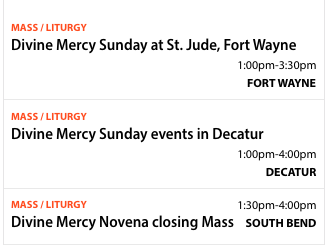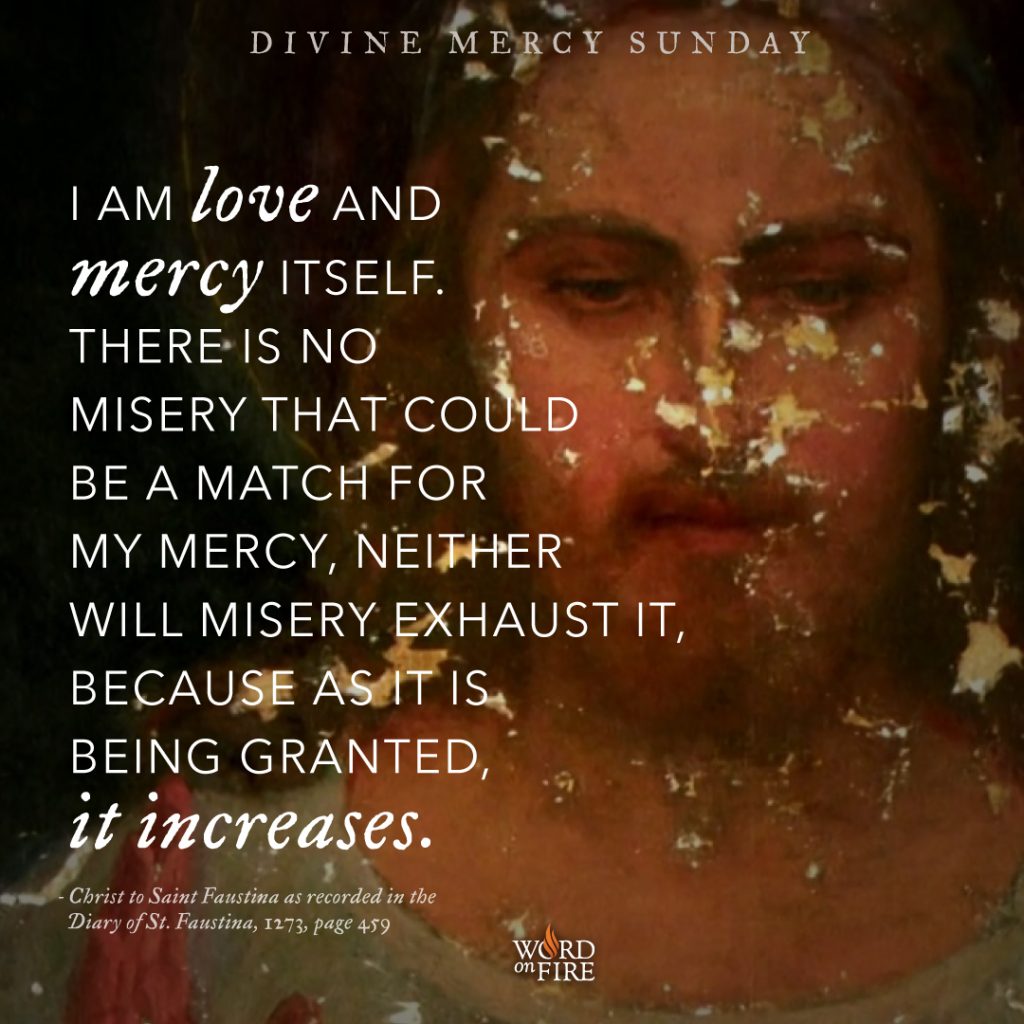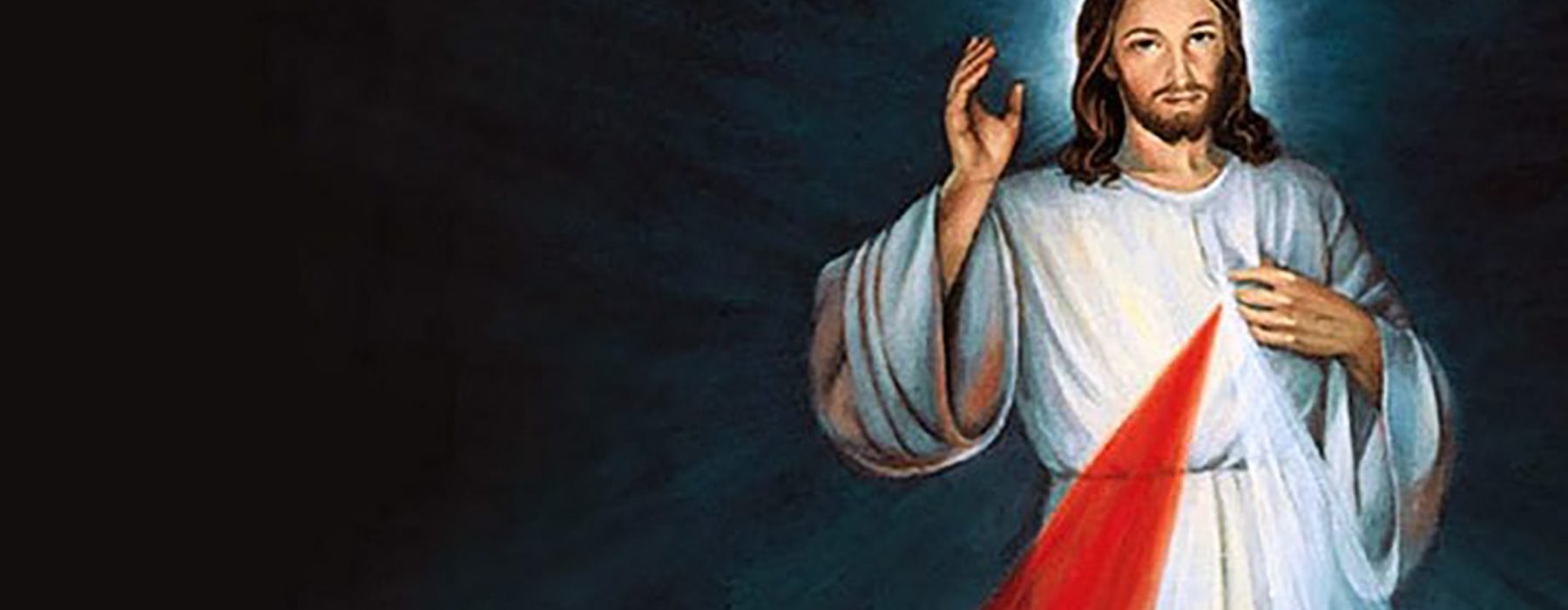April 23, 2019 // Diocese
Celebrating well: Divine Mercy Sunday
A week after Easter Sunday, a full eight days (or octave) later, the great g race of the holy day is often faded or forgotten. The jellybeans harden; the chocolate bunny is stale and the lamb cake gone. “Alleluia” becomes a commonly used word again. But in fact, the Sunday after Easter is an opportunity to experience abundant mercy, in the person of the now-risen Lord.
 Divine Mercy Sunday is the Second Sunday of Easter, proclaimed a universal feast for the whole Church by St. John Paul II in 2000. He stated: “Divine Mercy! This is the Easter gift that the Church receives from the risen Christ and offers to humanity at the dawn of the third millennium.”
Divine Mercy Sunday is the Second Sunday of Easter, proclaimed a universal feast for the whole Church by St. John Paul II in 2000. He stated: “Divine Mercy! This is the Easter gift that the Church receives from the risen Christ and offers to humanity at the dawn of the third millennium.”
Divine Mercy is not a new idea; rather, it comes from the core of sacred Scripture. The heart of the Gospel is God’s love and mercy for His people. It is this never-ending Divine Mercy and infinite love that is celebrated and emphasized on Divine Mercy Sunday.
“Be merciful even as your Father is merciful,” (Lk 6:36) is the Gospel command that speaks to the heart of the feast day of Divine Mercy. The Canticle of Zechariah, prayed every day throughout the world at the close of Morning Prayer in the Liturgy of the Hours, “speaks of the “‘tender mercy of our God.’” The parable of the prodigal son, in the person of the forgiving Father, highlights well God’s desire to be in relationship with His children. So Divine Mercy is not a new idea, but rather the core of the Gospel, spoken in a fresh way in the past century.

Divine Mercy Sunday is April 28. Jesus reminded His followers, through St. Maria Faustina Kolwaska, that, “when a soul approaches Me with trust, I fill it with such an abundance of graces that it cannot contain them within itself.”
Father Michael Gaitley, MIC, explains it this way: “The message of The Divine Mercy is simple. It is that God loves us — all of us. And, he wants us to recognize that His mercy is greater than our sins, so that we will call upon Him with trust, receive His mercy, and let it flow through us to others. Thus, all will come to share His joy.”
Divine Mercy Sunday is a great day of grace.
St. Maria Faustina Kolwaska, an uneducated Polish mystic and nun, had visions of Jesus. She was asked to write what she heard and saw in a book, which is called “The Diary of Sister Faustina.”
In 1931, she experienced a particular vision of Jesus, now known as the Divine Mercy. He asked her to paint the image. “Paint an image according to the pattern you see, with the signature: ‘Jesus, I trust in You.’ I promise that the soul that will venerate this image will not perish. I also promise victory over [its] enemies already here on earth, especially at the hour of death. I Myself will defend it as My own glory.”
Jesus’ death is the source of new spiritual life. The image of Divine Mercy depicts this, with Jesus, in His resurrected body, walking forward toward the viewer. His left hand pulls back His brilliant, white robe, allowing the streams of blood and water — rays of red and white in the image — to flow from His heart. Understood as cleansing and enveloping the faithful in His mercy, the blood and water also symbolize the sacraments of Eucharist and baptism.
The red and white rays also hold Scriptural significance. Jesus is often understood as the new temple, a reference to the Book of Ezekiel, in which the living water flows — an Old Testament image.
The Gospel writer John also connected the Prophet Zechariah’s words “they will look upon him who they have pierced,” (Jn 19: 36-37) to the crucifixion.
Jesus’ right hand is in a gesture of blessing, as His eyes gaze directly at the viewer. The hands and feet of Christ’s resurrected body are pierced: wounds of the Cross, suffered in love. This image offers the viewer to respond to Jesus clearly reaching out to them.
There is also a novena and chaplet of Divine Mercy. Traditionally it begins on Good Friday and follows for the next nine days, in preparation for the feast day of Divine Mercy, but can be prayed at any time. Prayed on regular rosary beads, the chaplet of Divine Mercy follows the words of the Mass: “I offer you the body and blood, soul and divinity of your dearly beloved son, in atonement for our sins and those of the whole world.” Three o’clock in the afternoon is often a time the chaplet is prayed, as it is a particular hour of mercy, the hour when Jesus expired on the cross after great suffering.
A few simple, practical spiritual ways to celebrate are:
- Pray. Pray especially at 3 p.m. for God’s great mercy.
- Offer a chaplet of Divine Mercy
- Sincerely repent of sin and attend the sacrament of confession beforehand
- Receive holy Communion at Mass
- Act with mercy towards others, in word deeds and prayer. Spiritual and corporal works of mercy are especially encouraged on Divine Mercy Sunday, to share in love the mercy given by God.
- Display and venerate an image of Divine Mercy. The image represents Jesus, who is love and mercy itself.
- Attend and pray at benediction and exposition of the Eucharist; contemplate He who was just received at Mass.
- Visit Jesus in adoration during Holy Hours. Jesus is the Divine Mercy incarnate and is truly present in the Eucharist.
- Focus and refocus and refocus as needed toward Jesus’ merciful heart. Returning time and time again to God’s heart is a choice, a deliberate act of will to come back to God.
- Those who are homebound might inquire at their parish if someone could bring Communion that day or make a special spiritual communion with great trust.
For more information, visit https://www.thedivinemercy.org/message/.
The best news. Delivered to your inbox.
Subscribe to our mailing list today.






